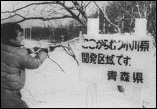|
|
 |
Producer, Director: Kuraoka Akiko Director, Editing, Sound Recording: Yamamura Nobuki Photography: Oda Hiroshi Sound Editor: Kubota Yukio 1985 / B? / 16mm / 171 min / English subtitles |
| The Shimokita peninsula of Aomori prefecture. At the beginning of the 1970s, in the village of Rokkasho situated at the base of the Shimokita peninsula, the prospect of sudden development and industrialization was raised. 10 years later it was decided that a giant petrochemical complex would be built, so the local people sold their land and left. Yet even now people continue to live in this "island on the mainland;" they continue to battle the forces of nature in this inhospitable climate that always leaves them with an insufficient harvest. In actuality, many of the old people who continue to work in agriculture or the fishing industry only settled here after World War II. The occurrence of both the "dollar shock" and the "oil shock" abruptly cut back the national development plans, undermining the anti-development movement so that the population of the village continued to decline. But the old folk, backed by their experience of surviving till now in the struggle against natural forces, carried on with contented smiles. Then, in 1984, almost as if it had been planned from the beginning, it was decided that a nuclear reprocessing facility would be built at Rokkasho. In consequence, the opposition movement quietly began to reform. Recognized until now for working under Tsuchimoto Noriaki to make Tokyo Chrome Desert ("Tokyo kuromu sabaku," 1978), a film that investigated sexivalent chrome pollution, the Yamamura-Kuraoka team took their 2 year old son with them to film in Kuraoka's home prefecture of Aomori. Shooting stretched out over 3 years until their son reached the age of 5. The son's inclusion in the film lends it a fresh sensibility. |